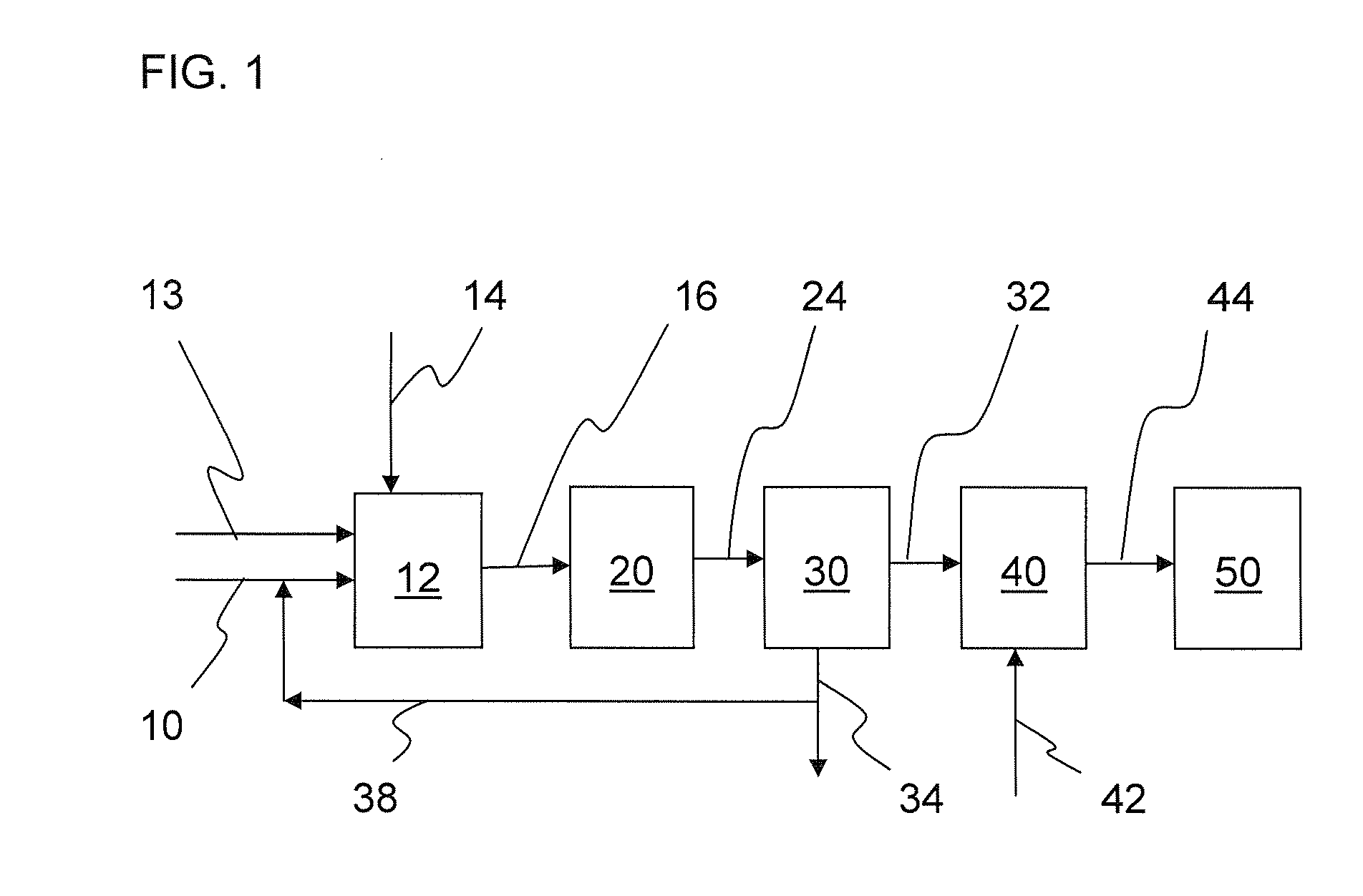Process for manufacturing ultra low consistency alpha- and beta- blend stucco
a technology of alpha- and beta-mixes and stucco, which is applied in the direction of calcium/strontium/barium sulfate, inorganic chemistry, calcium apparatus and processes, etc., can solve the problem of near theoretical water demand for use in the manufacturing process of boards, and achieve the effect of reducing energy consumption and reducing reactivity
- Summary
- Abstract
- Description
- Claims
- Application Information
AI Technical Summary
Benefits of technology
Problems solved by technology
Method used
Image
Examples
example 1
[0047]At a reactor temperature of 285° F. (141° C.), 90% of the gypsum fed to the first reactor was calcined to Alpha calcium sulfate hemihydrate. The resulting slurry was filtered and the filtered solids were further calcined in the Tube mill at 300° F. (149° C.). The filtered product before being fed to the Tube mill was kept at elevated temperature of 160-212° F. (71-100° C.). The Tube mill converted at least a portion of the calcium sulfate dihydrate of the dewatered solids into beta calcium sulfate hemihydrate. Thus, the resulting product had 90% alpha calcium sulfate hemihydrate and 8.5%-9% beta calcium sulfate hemihydrate for a total hemihydrate yield of 98.5% or higher relative to the amount of gypsum of the feed slurry. In other words, 90% of the gypsum of the feed slurry converted to alpha calcium sulfate hemihydrate and 8.5%-9% converted to beta calcium sulfate hemihydrate. The normal consistency of the resulting product was 32 cc.
example 2
[0048]At a reactor temperature of 280° F. (138° C.), 85% of the gypsum fed to the first reactor was calcined to alpha calcium sulfate hemihydrate. The resulting slurry was filtered and the filtered solids were further calcined in the tube mill at 300° F. (149° C.). The filtered product before being fed to the Tube mill was kept at elevated temperature of 160-212° F. (71-100° C.). The Tube mill converted at least a portion of the calcium sulfate dihydrate of the dewatered solids into beta calcium sulfate hemihydrate. The resulting product had 85% alpha calcium sulfate hemihydrate and 13.5%-14% beta calcium sulfate hemihydrate for a total hemihydrate yield of 98.5% or higher relative to the amount of gypsum of the feed slurry. The normal consistency of the resulting product was 34 cc.
example 3
[0049]At a reactor temperature of 275° F. (135° C.), 80% of the gypsum fed to the first reactor was calcined to alpha calcium sulfate hemihydrate. The resulting slurry was filtered and the filtered solids were further calcined in the tube mill at 300° F. (149° C.). The filtered product before being fed to the Tube mill was kept at elevated temperature of 160-212° F. (71-100° C.). The Tube mill converted at least a portion of the calcium sulfate dihydrate of the dewatered solids into beta calcium sulfate hemihydrate. The resulting product had 80% alpha calcium sulfate hemihydrate and 18.5%-19% beta calcium sulfate hemihydrate for a total hemihydrate yield of 98.5% or higher relative to the gypsum of the feed slurry. The normal consistency of the resulting product was 32 cc.
[0050]The data shows the present inventive process has the advantage that it results in a combined alpha calcium sulfate hemihydrate and beta calcium sulfate hemihydrate product that has a normal consistency simila...
PUM
| Property | Measurement | Unit |
|---|---|---|
| Temperature | aaaaa | aaaaa |
| Temperature | aaaaa | aaaaa |
| Temperature | aaaaa | aaaaa |
Abstract
Description
Claims
Application Information
 Login to View More
Login to View More - R&D
- Intellectual Property
- Life Sciences
- Materials
- Tech Scout
- Unparalleled Data Quality
- Higher Quality Content
- 60% Fewer Hallucinations
Browse by: Latest US Patents, China's latest patents, Technical Efficacy Thesaurus, Application Domain, Technology Topic, Popular Technical Reports.
© 2025 PatSnap. All rights reserved.Legal|Privacy policy|Modern Slavery Act Transparency Statement|Sitemap|About US| Contact US: help@patsnap.com

